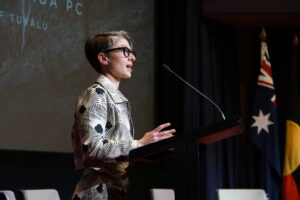The Wellbeing Framework’s metric of greenhouse gas emissions is the same one used by past climate-change denying governments
The most important issue for Australians’ wellbeing is to reduce greenhouse gas emissions and yet the government is not being honest about its progress in the the Wellbeing Framework.
The Wellbeing Framework released in July rightfully devotes a major section to “Sustainability” and contains a ranges of measures which counting aspects that “Protect, repair and manage the environment. Given climate change is the overriding issue that will determine the wellbeing not just of Australians but of everyone living on the planet it is vital that the government commits to “measuring what matters” in this area.
Unfortunately, it has chosen a woefully inadequate metric to measure our nation’s emissions that gives a dishonest account of our progress.
The truest measure of Australia’s impact on the world climate would be to count the emissions from not just within Australia but also those emitted elsewhere using our exported resources. The government however has decided in its Wellbeing Framework to only count emissions generated within our borders.
This would be acceptable except the government has not chosen to just count actual emissions but instead it has fallen back on using a measure that has long been the favourite of climate-change-denying governments in the past and included “Land Use, Land Use Change and Forestry” (LULUCF)
Including land use enables Australia to claim a reduction in emissions that does not involve actually reducing emissions, but rather just being less bad at cutting down trees than it was in the past.
It was this reasoning that was behind the Howard government lobbying for the so-called “Australia clause” in the Kyoto Protocol that used 1990 as a base year. The Parliamentary Library explains:
“the Australia Clause”… allows nations for which land use, land use change and forestry (LULUCF) were a net source of emissions in 1990 to add these emissions to their base-year calculations (which were used to determine emission targets). Australia was one of the few nations that were in this position in 1990 and recent analysis shows that Australia benefitted the most from this clause”.
Land Use was again included in the Paris Agreement targets agreed to by the then Abbott Government in 2015, this time using 2005 as its base year – another year in which there was abnormally high levels of land clearing – most notably in Queensland.
Worse still is that the measurement of land use has been prone to serious errors and a general lack of trustworthiness. For example in the latest quarterly greenhouse gas emissions data the government said that a satellite had been playing up and there were actually far more trees than they had realised, making Australia’s ‘net’ emissions even lower than they thought!
It is unfortunate that the Albanese Government has continued to rely on the ruse of including land use in order to make it appear as though Australia’s emissions have fallen. It is bad enough that they continue to rely on this measure for meeting the Paris Agreement targets of reducing emissions by 43% below 2005 levels, but that they have included the measure on its “Wellbeing framework” suggests an unwillingness to commit to serious action that will reduce emissions.
The Wellbeing Framework suggests the progress that has been made is “Improved 2005–2022” and that the “latest value is” “24.7% below year to June 2005 in year to December 2022”.
This is an incredibly dishonest measurement of our emissions reduction. Were we to appropriately count only actual emissions, the latest value would see Australia’s emissions just 1.3% below where they were in the year to July 2005.
The government’s measure is a political spin that hides the reality of our lack of action and the task ahead.
If we are to measure emissions reduction the Wellbeing framework should not use 2005 as a base year, and if it does, it should not include land use.
The wellbeing of all Australians living and those to come depends upon honest and true action to reduce emissions. The government’s measure of emissions reduction in the Wellbeing Framework currently fails to provide that and requires urgent changing. Failure to die so means it is difficult to place any store in the belief that the government is truly caring about the Australians’ wellbeing
Between the Lines Newsletter
The biggest stories and the best analysis from the team at the Australia Institute, delivered to your inbox every fortnight.
You might also like
The Wellbeing Framework needs to come up with more trustworthy ways to measure “Trust in Institutions”
The Wellbeing Framework attempts to measure how well Australians trust their institutions. Unfortunately, the government seems to have chosen measures designed to tell a good story.
The Climate Crisis is an Integrity Crisis | Polly Hemming
I am starting my address to this year’s summit in the exact same way that I started last year’s address. Because it is just over a year since I delivered these same words, which aren’t actually my words. They are the words of our Climate Change Minister, and they provide a baseline of sorts for what progress has been made in that time.
The Wellbeing Framework’s measure of innovation misses the mark
The Wellbeing Framework aims to measure what matters, but its measure of innovation has little to do with research or development


